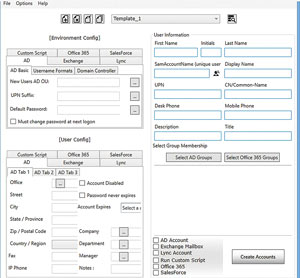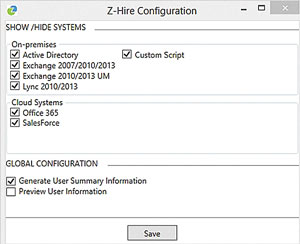Product Reviews
Review: Create Active Directory and Exchange Accounts with Z-Hire
Automation tool Z-Hire populates AD and Exchange Server mailboxes, as well as provisions Lync and Salesforce.com identities.
One of the largest challenges facing Windows administrators and IT pros is managing permissions and user access in Microsoft Active Directory. There are scores of solutions that take different approaches to managing Active Directory but one small Silicon Valley-based startup is taking a more holistic approach.
A company official told me he was frustrated with certain large vendors who sell buggy software at a high price tag. As such, his goal was to sell the software at an affordable price and invest the bulk of the proceeds into product development instead of marketing, thereby making it easier to produce a quality product.
I was intrigued by this philosophy but needed to evaluate the produced, called Z-Hire, to see if it was worthy. Zohno Inc. markets Z-Hire as an automation tool for IT user account creation. The tool is designed to automate the creation of Active Directory accounts, Exchange Server mailboxes, Lync accounts and Salesforce.com cloud accounts. The company claims Z-Hire can reduce the account deployment time by up to 600 percent.
The Deployment Process
For this review, I decided to focus on the tool's ability to create Active Directory accounts and Exchange Server mailboxes. I set up some Hyper-V virtual machines (VMs) to use in my evaluation. One VM was configured as a Windows Server 2012 domain controller. A second VM was configured as an Exchange Server 2013. I installed Windows 8 onto a third VM and used it to run Z-Hire.
Once all of my VMs were up and running, I downloaded Z-Hire. The download process really caught me by surprise. I had planned to start the download and then go get a cup of coffee but the download process completed instantaneously. When I checked to see what was going on, I discovered that the zip file containing the Z-Hire software was less than 3MB in size.
I was further surprised when I opened the zip file. I was expecting to find a Setup program but there was none. The Z-Hire folder contained an application icon and a configuration icon but no Setup icon. As it turned out, I was able to launch the application without having to work through any kind of Setup wizard (see Figure 1).
 [Click on image for larger view.]
Figure 1. The setup wizard lets you configure users.
[Click on image for larger view.]
Figure 1. The setup wizard lets you configure users.
Working with the Software
One thing I noticed is the software didn't render well on my system configured at the standard 1024x768 resolution. But once I switched to a computer with a resolution of 1280x1024, it was no longer a problem. Once I got past the display problems I wanted to move on to the actual user account creation process. Setting up user accounts is a tedious process, so I wondered how an application could make the process less time-consuming. After all, there's still information that has to be entered for each user.
The Z-Hire approach actually makes a lot of sense. The software allows for the creation of templates. By default five templates are included, which can be renamed to meet your needs. For example, you might create one template for the marketing department and another template for the finance department. The templates store the repetitive information you would normally have to enter for each account that's being created. You can also create new templates on the fly or remove unwanted templates.
Another thing I really liked about the software is there's a Configuration screen that allows you to hide any parts of the software you aren't using (see Figure 2). For example, because I'm focusing on Active Directory and Exchange Server 2013, I was able to hide interface items related to Office 365, Lync and Salesforce.com.
 [Click on image for larger view.]
Figure 2. Using the Configuration screen, you can hide parts of the interface you don't need.
[Click on image for larger view.]
Figure 2. Using the Configuration screen, you can hide parts of the interface you don't need.
At this point, I decided to modify one of the default templates. I renamed the template to Lab User and populated some of the fields that would normally be really repetitive. I especially liked the fact that I was able to select an existing Active Directory OU and UPN suffix. Other objects could also be selected from Active Directory, such as Office and Manager.
I was especially impressed with the Exchange Server template options. I expected the software would allow me to select a mailbox server and a mailbox database, set some quotas and so on. However, the software far exceeded my expectations by providing options to set an additional SMTP address, a Forward To address and even to grant Send on Behalf of permissions. There was even a checkbox that could be used to hide the user from the Global Address Book.
The process of building a template took the guesswork out of the process. Whenever possible I was able to select an object from Active Directory rather than having to specify its User Principle Name (UPN) or Common Name (CN). For example, I was able to select the Exchange Server name, mailbox database name, ActiveSync policy and more.
Once I had set up a template, I wanted to see how well the software would create a user account. For this test I decided to create an Active Directory user and a corresponding Exchange Server mailbox. The account creation process is based on Windows PowerShell remoting. Because Windows PowerShell can be very picky at times, I decided to see what would happen if I omitted data from some critical fields. As I expected, the software displayed a dialog box telling me exactly what information was missing.
The software has a built-in 15-second delay that occurs after the Active Directory account is created, but before the Exchange Server mailbox is created. This delay allows the Active Directory replication process to occur. Otherwise, the mailbox creation could fail if Exchange is unaware of the Active Directory account's existence.
During my tests, I created several accounts. The process seemed to work flawlessly. Even so, I took the time to verify the accounts had indeed been created properly.
| REDMOND
RATING |
Installation:
20% |
10.0 |
Features:
20% |
9.5 |
Ease of Use:
20% |
9.0 |
Administration:
20% |
10.0 |
Documentation:
20% |
8.0 |
Overall
Rating: |
9.3 |
Key: 1: Virtually inoperable or nonexistent 5: Average, performs adequately 10: Exceptional
|
|
|
Recommendations
Overall I really like Z-Hire. I was initially skeptical that an application could reduce the amount of time it takes to set up user accounts. However, after seeing how the templates work and spending some time with the application, I can definitely see how it could be a time-saver. The one thing the company should resolve is to address the screen resolution issue so those with limited displays can view the screens.
Even though I was unable to quantify the amount of time it took me to set up accounts in a way that confirmed or debunked the Zohno Web site's claim of a 600 percent reduction in account creation time, the process was decidedly faster than manually setting up fully provisioned accounts
Z-Hire
$250 for up to 1,000 users; up to $2,500 for shops with more than 5,000 users.
Zohno Inc.
zohno.com
About the Author
Brien Posey is a 22-time Microsoft MVP with decades of IT experience. As a freelance writer, Posey has written thousands of articles and contributed to several dozen books on a wide variety of IT topics. Prior to going freelance, Posey was a CIO for a national chain of hospitals and health care facilities. He has also served as a network administrator for some of the country's largest insurance companies and for the Department of Defense at Fort Knox. In addition to his continued work in IT, Posey has spent the last several years actively training as a commercial scientist-astronaut candidate in preparation to fly on a mission to study polar mesospheric clouds from space. You can follow his spaceflight training on his Web site.